Founder's Note
To our community:
In 2016, we founded DÔEN. After years spent in the fashion industry, the lack of representation of women at the helm of fashion brands was alarmingly clear. With thoughtful determination, we brought together a collective of LA-based women-identifying creatives and business leaders - all equity owners - to launch DÔEN with the goal of creating a direct to consumer organization that put women first while honoring the true partnership of individuals who helped to build it.
With ownership comes responsibility, a responsibility to our community, our value chain, our growing team, and the world as a whole. Our industry, while contributing to so much beauty, creativity and personal expression, also undoubtedly poses a strain to our climate and the communities where product is made. We are cognizant of these challenges and this report is an acknowledgement of where we stand and what we hope to be and achieve - with a recognition that there is, and always will be, room to collectively do better.
As women, we experience a cultural expectation and, speaking for ourselves, a very personal desire to strive for and achieve perfection. This idea of feminine perfection is ingrained in us from a young age and, with that, we’re often stunted in our pursuit of goals in fear of achieving anything less than this unattainable feat. With our 2030 Roadmap, we’re acknowledging and accepting that perfect isn’t possible, and we can’t and won’t let perfection hinder progress. This is a working, living document, one that will continue to evolve and expand as we learn more about how we can best exist in a world calling for action.
We’re beyond grateful for the incredible partners we’ve had in building out and assessing our current state - environmentally and socially - who share our passion and mission in creating lasting collections while supporting the people in all aspects of our organization, value chain, and community.
And to you all, thank you for your support - for your encouragement and your feedback - as we continue to build what is DÔEN.
Katherine and Margaret Kleveland
1. Our Framework
Our mission is to create lasting, beautiful collections while supporting women-identifying individuals in all aspects of our organization, value chain, and community. Within that mission, our 2030 Roadmap lays out our approach to business: to view our supply chain as a value chain, and to commit to creating more environmental and social value across every tier and function of that model.
We believe that climate change affects us all—with the most immediate effects of our clothing production choices impacting the communities in which our garments are made. Our manufacturing practices impact the local water sources of our factories, the air the workers breathe, and the food grown nearby. We take the climate crisis seriously and have therefore chosen to pursue an aggressive carbon reduction strategy to underpin our business operations.
Our Roadmap is multidisciplinary. As guideposts, we look to other brands that have accomplished impressive feats in value chain work, contributing to collective, industry-wide practices, and to academic research that dispels industry trends and rein- forces core employee welfare principles. To generate more social value across our supply chain, we have decided to align our strategy to these proven practices, with a focus on female empowerment across our workforce.
As a fashion business, we firmly believe that we can synergize product creation with contribution to the public good, extending our values across the supply chain and decoupling resource extraction from business growth as key product value enhancements. We know this path is not straightforward, and that it will require iterative reexamination and redirection. Our next step will be to perform our own internal value chain due diligence in the forms of and collection. Parallel to this work, we will partner with stakeholders across the fashion industry to combat the systemic challenges facing the sector at large. Partnership is essential—not only for solutions, but also to create an inclusive approach to any of our efforts. The voices of our employees, garment workers, and community will continue to guide our strategy over the years.
A work in progress, the 2030 Roadmap will continue to evolve, enhanced by valuable input from our . This work is purposeful—and while we recognize that perfection is unattainable, our primary goal is to do better. As we move forward, we vow to examine our practices, hold self-reflection in high regard, admit our mistakes, and strive to do better. We look forward to sharing this journey with you.
2. Alignment to the SDGs
We have aligned our 2030 Roadmap to the , the global framework for tackling the world’s greatest challenges. Our intention is to contribute to the collective system change required to accomplish the SDGs by 2030. As such, we have designed a strategy that marches toward 2030, but will continue to report on our progress on an annual basis. We have highlighted the following SDGs in our strategy.
Our intention is to contribute to the collective system change required to accomplish the SDGs by 2030.
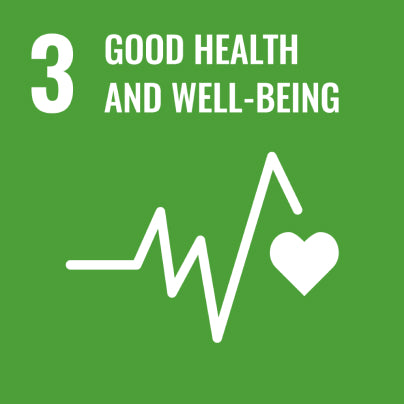
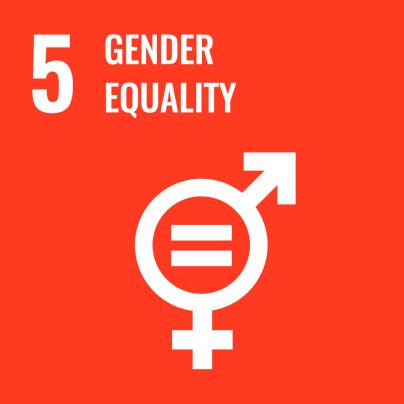
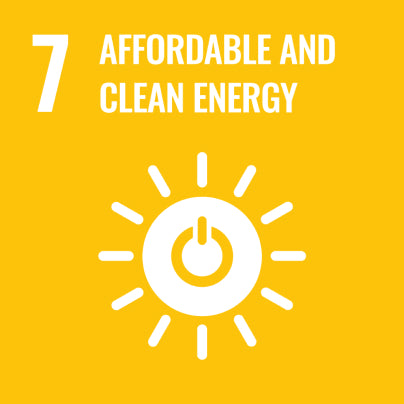
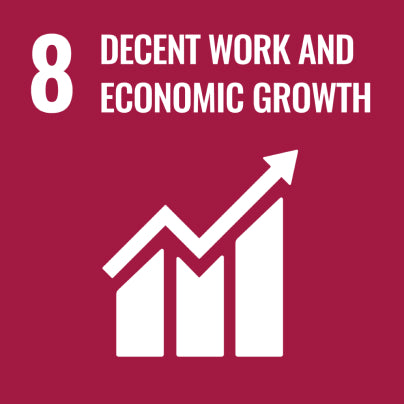
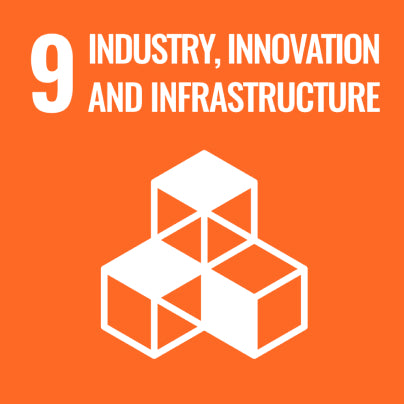
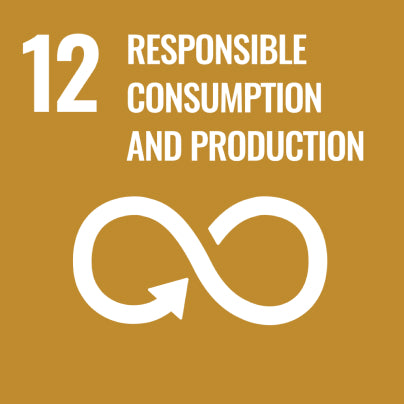
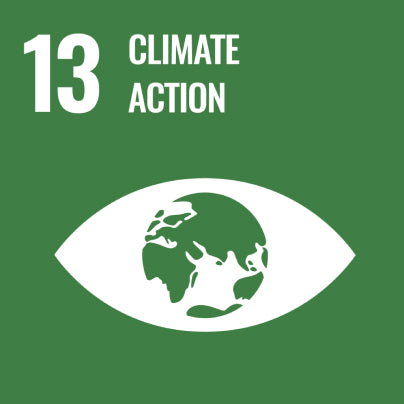
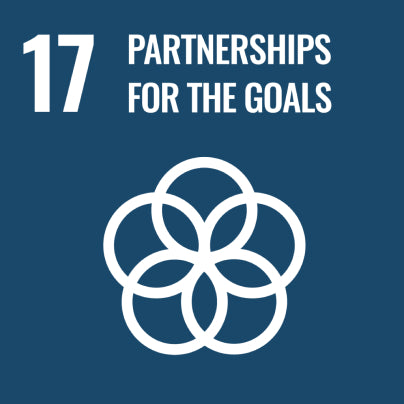
3. Our Commitment to Traceability
To reduce DÔEN’s environmental impact in the most effective way, we must first analyze our own value chain—from raw materials at the farm level to the who cut and sew our garments to how those garments are shipped to our customers. To that end, we prioritize the collection and usage of primary data—or, first-hand data gathered directly by us and our consultant partner—to inform our 2030 Roadmap. We strive to stay informed on industry best practices and sustainability trends, and we have determined that a more customized approach will result in the most viable and meaningful reduction of our brand’s impact.
Primary data collection is especially important when mapping and calculating our . When primary data is too cumbersome or intensive to collect, it is common practice to rely on available from leading industry tools and data sources. We recognize the limitations of even the most well-regarded industry tools, whose data sets are sometimes too specific or too broad for us to make informed decisions from—but they are currently the best option we have for missing data points.
Therefore, we plan to perform DÔEN-specific supply chain and material analyses in order to further understand our emissions at a product level and lessen our reliance on secondary data, reassessing our emissions on a yearly basis. Our intention is to use more primary data to garner a more accurate understanding of our impact—and how we can most efficiently reduce it. We will first start with our alpaca supply chain in Peru and chase our supply chain down to the farm level, gathering key pieces of intelligence along the way. We hope this practice of annual due diligence will add value to our suppliers too, enabling them to better understand their own material footprints.
Our intention is to use more primary data to garner a more accurate understanding of our impact—and how we can most efficiently reduce it.
4. Our Environmental Strategy
Overview
According to some reports, the fashion industry accounts for approximately 5% of global greenhouse gas (GHG) emissions.1 As GHGs are emitted—primarily due to human activity—they become trapped in the atmosphere, which warms the planet and causes climate change. These changes have already had devastating global consequences such as deadly floods, storms, and droughts— which affect not only humans (and disproportionately, our most vulnerable populations) but also animals, vegetation, biodiversity, and sources of food, fuel, and fiber. As such, we have decided to focus our efforts on fighting the climate crisis and a commitment to reducing our carbon footprint.
We have decided to focus our efforts on fighting the climate crisis and a commitment to reducing our carbon footprint.
In 2022, we partnered with a third-party consultancy, dagny&, to map and measure our greenhouse gas (GHG) emissions in order to assess our , as well as climate risks and opportunities for improvement. We established 2021 as our benchmark year for calculating GHG emissions across our entire supply chain ()2. Further details about our sources of emissions and calculation methodologies can be found in the table below.
Methodology
According to industry reports, over 80% of the fashion industry’s falls under Scope 3 (specifically, reducing emissions from upstream operations and understanding our full lifecycle footprint)3. The remaining 20% of abatement potential lies in Scope 1 and 2, or those emissions under a brand’s own operations. Using the data from our GHG emissions assessment, we have created a custom carbon strategy that attempts to capture those abatement opportunities, starting with direct reductions in our own operations all the way through to goals. The mitigation matrix below further outlines these opportunities.
We’ve aligned our carbon reduction goals to the Science-Based Target initiative (SBTi)
We’ve aligned our carbon reduction goals to the – which sets emissions reduction targets in line with climate science to limit global warming to 1.5°C above pre-industrial levels4. Our goal is a 38% absolute reduction by 2030 across Scope 1 and 2, and are working toward a year-over-year energy intensity reduction for Scope 3. While our first priority is to reduce our carbon emissions throughout Scopes 1 through 3, we are also open to considering beyond the value chain mitigation tools, including high quality carbon credits. Collectively, we will be unable to solve the climate crisis unless we stop deforestation and restore grasslands, wetlands, and forests – all of which require investment from companies. Carbon credits – when they are verified, high integrity, and high quality – can support biodiversity and local communities while protecting crucial existing carbon stocks.
DÔEN also adheres to the , a set of policy and practical guidelines that support an equitable transition to a low carbon, circular economy5. In accordance with the JT principles, our carbon goals take into consideration those in our supply chain who might be adversely affected by our carbon reduction strategies, such as suppliers, factory workers, and farmers without the financial resources to implement new technologies or reduction measures. We value partnership and collective problem-solving across our supply chain to mitigate any unjust consequences of our carbon strategy.
Hand Me DÔEN
Designing timeless pieces to be loved and passed down has been at the heart of DÔEN since we first launched in 2016. In October, we proudly introduced Hand Me Dôen, furthering our commitment to creating products that last and move beyond linear business models to minimize our environmental footprint. With the launch of our own resale program, we hope to empower our community to find joy and value in wearing and sharing preloved garments, and therefore extending the mileage in each of our garments. Starting with 2022, we will begin to incorporate the Hand Me Dôen carbon footprint in our annual mapping.
Opportunities
A mitigation matrix displays the projected amount of GHG savings from the implementation of new projects, as well as the associated costs of such projects. The x-axis represents the estimated reduction impact from low to high, while the y-axis represents the cost from low to high. The matrix below is specific to DÔEN, informed by detailed analysis of the brand’s supply chain and its emissions profile.
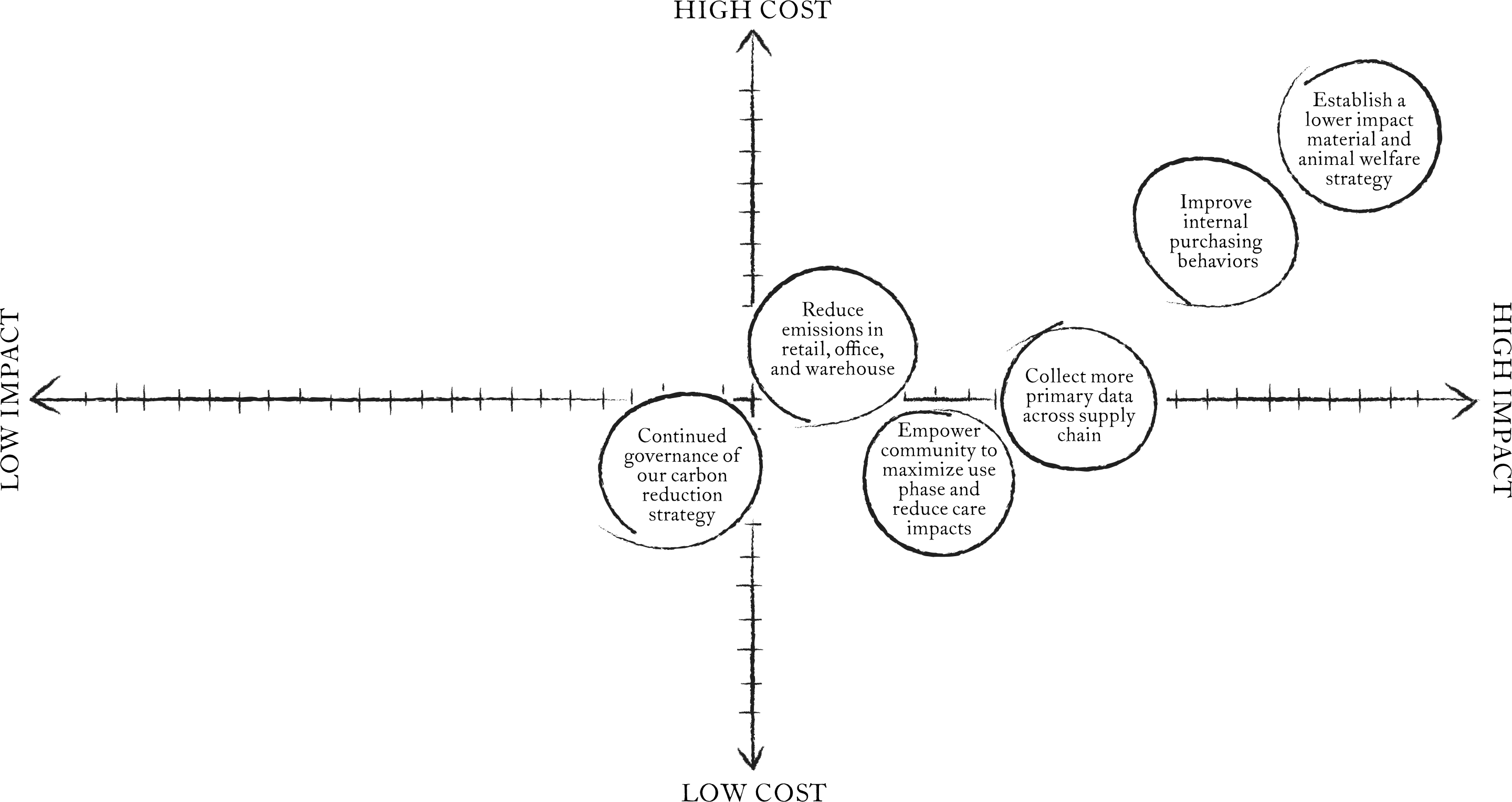
5. Our Social Strategy
Overview
We believe that amplifying the voices of the workers in our value chain and equipping women-identifying individuals with meaningful employment and will have a ripple effect in their communities. We have the unique opportunity to leverage our business into a vehicle for and the potential to help lift communities out of poverty. Although our supply chain is humble in size, we aim to add value to workers’ lives however and wherever we can. Our vision is to establish an entirely new precedent for buyer-supplier relationships at our scale of business.
In keeping with that goal, we are partnering with RISE (Reimagining Industry to Support Equality) to bring the industry’s leading women’s empowerment program to our supply chain. A joint initiative between BSR HERproject, Gap Inc.’s P.A.C.E. program, Better Work, and CARE, RISE seeks to catalyze collective action at scale for the benefit of women workers and gender equality in global supply chains. For the most part, factory and worker empowerment programs have been implemented by the industry’s biggest brands, given their leverage within factories and the breadth of their resources. Smaller brands like ours have fewer opportunities to engage meaningfully at a worker level across global supply chains. Our partnership with RISE will function as a test case for smaller brands to join this important work and to leverage their supply chains for social impact. We hope to expand implementation of the program annually, from region to region, and to act as a resource for other brands in the future.
Along with our work at the factory level, we know our behavior as the brand client affects the working conditions of our garment workers. Research has shown that a brand’s have a significant impact on the of garment workers6, and that these outcomes are even different for female workers7. With that in mind, we must examine our own purchasing practices to identify opportunities for improvement. Our goal is to add value across our factories, without the addition of . Though our relationships with our suppliers are strong, there is infinite room for improvement.
Our goal is to add value across our factories, without the addition of redundant programs or protocols.
We recognize that the workplace plays an important role in the satisfaction and wellbeing of the individual. We are committed to helping our factories create work environments that are safe, healthy, and supportive of our garment workers’ emotional and physical wellbeing.
6. Our Community Advocacy
As a fashion brand, we have the capacity to influence behavior change across our community by using our platform to champion causes we hold near and dear. We are privileged to have an incredible customer community, who is curious, engaging, and passionate about our impact work. To that end, we will endeavor to use our voice to advocate for public policy that improves the fashion sector at large and supports women-identifying individuals.
Since the beginning of the brand, we have partnered with organizations that share our vision of progress and equality. Our philanthropic partnerships with Planned Parenthood L.A., Room to Read, and Kindred Space LA remain key elements of our impact strategy. We are proud to continue this work with each of these community leaders.
7. Our Future
We’ve dedicated the past year to understanding and designing our impact strategy up to this point, and we’re eager to dive deeper. We recognize that our 2030 Roadmap thus far is not representative of the full scope of work that lies ahead. With the support of technical and science-backed expertise, we intend to build out strategic programming around our water consumption, our chemical usage, and our waste footprint. Embarking on each of these agendas will require deliberate, strategic focus—and we want to honor that process.
Each year of implementing our 2030 Roadmap will require introspection, re-evaluation, and renewed commitment, and we will update our community annually with our progress in our yearly impact update reports. As the industry evolves and sustainability technology develops, our strategy, too, will change and grow. Our pledge to march towards progress and continuous improvement, however, will remain steadfast. Gathering higher quality data, investing in our partnerships, and relying on our culture of collective problem-solving will bring us closer to our version of driving impact through business.
8. Appendix
Glossary
absolute emissions reduction:
The reduction in the total amount of greenhouse gases (GHGs) emitted by a company in the target year, relative to the base year. For example, if a company emits 100 tonnes carbon dioxide equivalent or CO2e (a consolidated GHG metric) in 2020 and commits to a 50% absolute emissions reduction by 2030, then their absolute emissions reduction in 2030 should be 50 tonnes CO2e.
carbon footprint:
The total amount of carbon dioxide (CO2) emitted by an individual, company, organization — or even country — over a defined period of time (i.e. lifetime, year, day, etc.). As CO2 is the most abundant greenhouse gas emitted through human activities, it's important to track and measure it — and find ways to reduce it.
carbon intensity reduction:
The reduction in GHGs emitted by a company on a per unit basis (for example: per dollar or per garment). To calculate this, the company decides on the intensity metric and then divides their total emissions profile by that metric.
carbon offsets:
Financial investments in projects that theoretically reduce GHG emissions or increase carbon storage and which are used to compensate for emissions that occur elsewhere. Some examples of carbon offsets are investments in projects to build clean energy or restore lands such as forests.
emissions abatement potential:
The expected GHG reduction on a scale of magnitude, broken down by different programs, processes, policies, technologies, etc.
fieldwork:
The research and collection of primary, raw data outside a laboratory, library, or workplace setting.
financial agency:
A person's ability to make economic decisions about their household and life. A person with financial agency has the purchasing power to invest in better nutrition, access to education, family planning, and other key factors that shape an individual's livelihood.
GHG emissions:
The sum of emissions from six main greenhouse gases (carbon dioxide, methane, nitrous oxide, hydrofluorocarbons, perfluorocarbons, and sulphur hexaflouride). As these gases are emitted, through human and natural causes, they become trapped in the atmosphere, contributing to global warming and climate change.
health outcomes:
Measure a change in the health status of an individual or a group which can be attributed to an intervention. In this context, we are interested in the different or improved health outcomes of garment workers across our value chain as a result of our impact strategy.
ILO Just Transition Guidelines:
Provide a framework for an equitable transition to an environmentally sustainable economy, with special consideration for providing decent work, social inclusivity, and the eradication of poverty. Discover more
primary data:
Any data set collected first-hand by the researcher themselves.
secondary data:
Any data set collected by a researcher other than the one using it.
purchasing practices:
How a company engages with the vendors in their supply chain (i.e. payment terms, price negotiations, shipping methods, garment quality control, etc).
redundant programs or protocols:
Often, garment factories are asked by their brand clients to implement different versions of worker-centric programming that ultimately strive to accomplish similar goals. Having redundant programs or protocols creates programming fatigue for the factory and workers without actually adding incremental value at the workplace.
Science Based Targets Initiative (SBTi):
A partnership between CDP, the United Nations Global Compact, World Resources Institute (WRI), and the World Wide Fund for Nature (WWF). The entity drives ambitious climate action in the private sector by enabling organizations to set science-based emissions reduction targets. Science-based targets (SBT) provide a trajectory for companies to reduce their GHG emissions consistent with the level of decarbonisation that is required to keep global temperature increase within 1.5 to 2°C compared to pre-industrial temperature levels. Discover more
Scope 1, 2, and 3:
The three categories of GHG emissions as definied by the GHG Protocol Standard. Scope 1 are direct emissions caused by a sources controlled or owned by a company. Scope 2 are indirect emissions associated with the purchase of electricity, steam, heat, or cooling. Scope 3 are indirect emissions from assets across a company's value chain that it does not own or control, but that it impacts.
stakeholders:
Individuals, companies, and organizations that are impacted by or invested in a project (i.e. business owners, investors, employees, customers, suppliers, and vendors).
sustainable development:
An organizing principle for meeting human development goals (i.e. improved health, education, and livelihoods) while simultaneously sustaining the ability of natural systems to provide the natural resources and ecosystem services on which our economy and society depend. It is the basis of the Sustainable Development Goals, and is considered to be the solution to the natural friction between environmental degradation and societal growth.
Tier 4 supplier:
The farm or source of the raw materials used for textiles.
United Nations Sustainable Development Goals (UN SDGs):
A list of 17 targets to help achieve a more equitable and sustainable future. They address the global challenges we face, including poverty, inequality, climate change, environmental degradation, peace, and justice. Discover more
value chain:
The sum of a company's vendors and suppliers, as well as the activities that each entity performs on behalf of the company, in order to deliver a final product to the end customer. For an apparel company, this can include cotton farmers, textile mills, garment sewers, shipping agents, packaging suppliers, etc. In this context, we also include the social and environmental value transacted across these activities and entities.
vendors:
An entity that sells specific goods or services to another company (i.e. garment factories, textile manufacturers).
Footnotes
1 McKinsey & Co. 2020. Fashion on Climate: How the Fashion Industry Can Urgently Act to Reduce Its Greenhouse Gas Emissions.
2 Methodology: Dôen’s carbon footprint calculation adhered to the GHG Protocol’s Corporate Accounting and Reporting Standard, as well as The Greenhouse Gas Protocol: Technical Guidance for Calculating Scope 3 Emissions.
3 McKinsey & Co. “Fashion on Climate: How the Fashion Industry Can Urgently Act to Reduce Its Greenhouse Gas Emissions.” McKinsey & Co., August 2020. mckinsey.com/~/media/mckinsey/industries/retail/our%20insights/fashion%20on%20climate/fashion-on-climate-full-report.pdf. Accessed: 1 April 2022.
4 Science Based Targets. 2021. About Us. SBT. www.sciencebasedtargets.org/about-us
5 International Labor Organization. 2015. Guidelines for a just transition towards environmentally sustainable economies and societies for all. ILO. www.ilo.org/wcmsp5/groups/public/---ed_emp/---emp_ent/documents/publication/wcms_432859.pdf
6 McNeely, Eileen. (2020). “Well-being and Equity as a Business Imperative.” October, 2020. Accessed September 27, 2022: https://www.levistrauss.com/wp-content/uploads/2021/05/Harvard-SHINE_WWB-Impact-Study-Summary-Report_12-October-2020.pdf





























